Tactics Ogre: Reborn Review
Although Tactics Ogre: Reborn is technically a remake of a remake, it is one that I’ve welcomed ever since it was finally announced (after a series of leaks). Tactics Ogre is one of the most wonderful strategy RPGs I’ve ever played - both the original version and its first remake on PSP. It has one of the most compelling narratives I’ve seen in an RPG, and its cast is superb in fleshing out its tale.
Despite my love for Tactics Ogre, I know that these aren’t perfect games. Each of the previous versions were cumbersome or frustrating in its own way, so I hoped Tactics Ogre: Reborn would serve as the “definitive” edition for this excellent strategy RPG at last; naturally, Reborn will be the version that’s easiest to play as time goes on, due to its availability on modern PlayStation & Nintendo platforms, as well as PC.
If this is your first time playing Tactics Ogre, you’re in for a treat. Tactics Ogre: Reborn is absolutely the most user-friendly version yet. Several tedious systems and mechanics from previous releases have been revamped in a way that doesn’t compromise its difficulty. You will still be faced with challenging battles that require a lot of situational awareness, tactical maneuvering, and proper danger assessment.
However, as someone who is familiar with Tactics Ogre’s previous releases and now Tactics Ogre: Reborn, I hesitate to call this the “definitive” version. It is, by no means, a bad version of it, but I come away mixed on many of the gameplay alterations that Reborn has arbitrarily added.
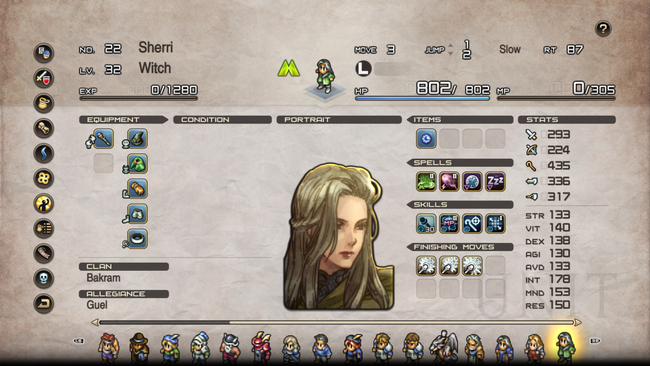
I hoped for Tactics Ogre: Reborn to simply iron out several rough edges of previous releases and balance out some of the overtuned party compositions and strategies that destroyed the game’s difficulty previously. What I got was those, plus an entirely new, different gameplay experience that has left me a tad disappointed.
Tactics Ogre: Reborn is certainly the easiest to recommend to newcomers with its plethora of quality-of-life improvements, for sure, though some returning Tactics Ogre players may be in for a rude awakening at how Tactics Ogre: Reborn has changed things up.
As with all releases of Tactics Ogre, the primary focus of its gameplay revolves around traversing an overworld map from battle to battle. Story scenes play out before and after stages with the occasional mid-battle dialogue. Allies and enemies take turns on a grid tile-based map with varying environments and topography to consider - because elevation and line-of-sight are accounted for when executing an action.
One of the first tweaks that veterans will notice right away are the inflated stat values throughout everything - more HP, higher damage numbers, and such. It takes a bit more time to eliminate foes if players aren’t employing one of the new primary systems introduced in Tactics Ogre: Reborn.

There are now several types of cards that randomly spawn throughout fights that affect stats temporarily; blue cards will provide a stat enhancement, while red cards will erase buff cards if the unit that lands on them has any. Buffs can range from increasing physical or magical attack damage, increasing the amount of MP restored per turn, increasing the probability of a critical hit occurring, and increasing the chances a character’s auto skills will trigger when their turn arrives. The damage increase from a single buff card is significant, and any unit, friend or foe, can stack up to four of these buffs.
Due to the random appearance of these cards on every map, Tactics Ogre: Reborn transforms what used to be a slower, yet meticulous, gameplay flow into something that feels more uneven. Fights in Tactics Ogre: Reborn often feel sluggish until some units get some buff cards on them to remarkably speed up the fight.
Another major change in Tactics Ogre: Reborn is that it no longer has a separate gauge for Tactical Points (TP). This resource was previously utilized for certain skills and powerful Finishing Moves for different weapon types; TP was gained through receiving attacks, so building it up took a bit of time in fights.
Now, everything has been consolidated into using MP and only MP now. Several skills and all Finishing Moves consume MP, along with magical offensive and defensive spells. Additionally, some key skills have now been relegated to auto skills. This type of skill has a random chance to activate automatically at no MP cost before a unit takes their turn.
For instance, the Meditate and Berserk skills are now auto skills so spellcasters can potentially enjoy a healthy amount of MP regeneration through Meditate without having to rely on consumable items as much. Berserkers can now potentially output an insane amount of damage consistently because Berserk now grants a big damage bonus on top of its area-of-effect modifier, but the trade-off is that its activation is no longer manually controlled.
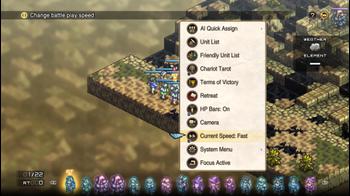
This simple change of letting go of the TP gauge, unifying everything under MP, and introducing auto skills drastically alters the balance of Tactics Ogre in intriguing ways, as it opens up new avenues for historically underwhelming classes to shine now. Rune Fencers, Valkyries, Knights, Terror Knights, and other unpopular classes are quite viable now. Meanwhile, Archers, Ninjas, and Kunoichis have been toned down from their previously godly incarnations; they are still decent, though they are more specialized in dealing damage to backline less-armored units now, instead of being the universal answer to everything.
While these are pretty exciting changes at first, these alterations come with their own share of problems too.
Most of the problems I have with these new systems are exemplified in the final battle of a chapter that involves the protagonist Denam, three NPC allies, and a single boss. The enemy boss is already pre-stacked with four buff cards (several of which increase their damage output) and comes equipped with the Phalanx auto skill. Phalanx drastically increases a unit’s defense until their next turn and since it is now an auto skill, it has a chance to activate consecutively. The boss can easily annihilate Denam and his allies in a few attacks, so it effectively becomes a fight entirely decided if the stat card drops in favorable situations and circumstances fast enough for Denam to kill the boss before it kills him, assuming Phalanx isn’t activating that much. It’s a form of rocket tag that isn’t fun to engage with, quite frankly.
The Union Level mechanic marks another major change in Tactics Ogre: Reborn that personally doesn’t bother me all that much, but I can see this being irksome for several players. Union Level is effectively a level cap that gets higher as players progress the main story. The maximum Union Level at any given time will usually be two levels below major bosses, so Tactics Ogre: Reborn forces players to think on their toes and ensures that no one can overcome its challenges by simply grinding out levels.
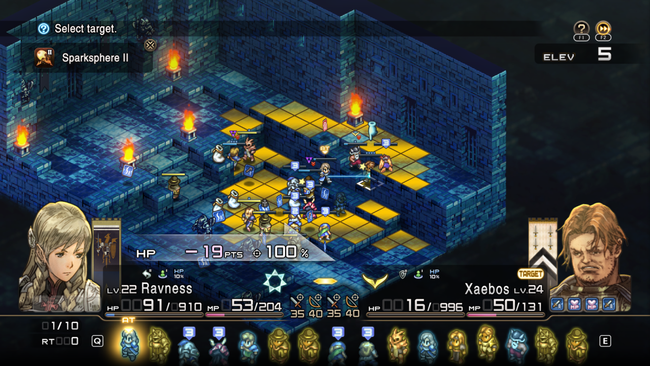
Speaking of levels, one of the main concerns Tactics Ogre players had with previous versions was the tedium of grinding levels for new classes they obtained. In the PSP remake, classes themselves had their own job experience to level up, so if the Warrior class reached level 10, then every Warrior in your party was level 10. The problem here, in the PSP version, was every new class obtained always started at level 1, and there was no easy way to catch new classes up to the rest of your party’s levels aside from merely setting aside time to grind them.
Tactics Ogre: Reborn reverts back to how the original Tactics Ogre release handled classes as people only have to be concerned with a unit’s individual level now and their classes are assigned per unit. Players can change a unit's class through consumable classmark items, but it will retain that unit’s current level no matter what.
Additionally, if there are any underleveled units that you want to catch back up in levels, the Union Level helps supplement this end of the equation. After a stage ends, the grand total amount of experience received is divided up among anyone in the party that is not already at the Union Level cap. Therefore if one or two fresh units are put in a party of level-capped members, then they will receive a substantial amount of experience as it is all funneled to them.
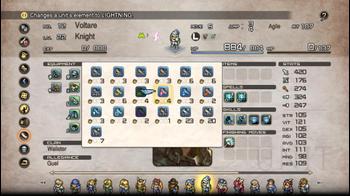
Yet another new addition in Tactics Ogre: Reborn are Charm items. Experience Charms can be consumed to immediately give a unit experience right away. Sometimes if there’s a large amount of experience points that no one can receive after a stage, a chunk of that will be turned into an Experience Charm to use later as well.
This is a welcome change that vastly streamlines the leveling system; it doesn’t get in the way and I’ve hardly ever thought about grinding levels.
For those who do want to grind unit levels and/or skill proficiency levels, new replayable training stages take the place of random encounters. These training stages are fairly easy and low stakes; if an ally unit falls in battle, they do not permanently die after three of their turns pass when in a downed state. On the flip side, enemies do not drop loot at all in training stages. To replay battles with loot that you can sell, revisiting optional dungeons will fill that role if your funds get low.
There are also many usability improvements in Tactics Ogre: Reborn across the board. Players are able to scout maps before starting the battle, allowing them to view the enemy’s formations, equipment, and abilities to better plan for them. Battles have optional sub-objectives now that grant additional experience points, equipment, and charms.
Crafting is significantly less of a pain now too. It no longer has a chance to fail on equipment upgrades and players can craft multiple things at once. There are multiple options allowing all equipped armor pieces to be upgraded simultaneously too, or if you prefer crafting each mat one-by-one.
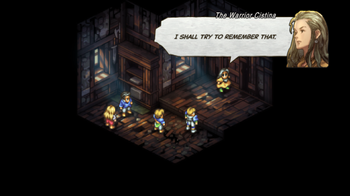
Perhaps the most significant bullet point surrounding Tactics Ogre: Reborn before it was released was its remastered visuals. Free from the chains of the technological restraints that bound the original on SNES and the first remake on PSP, there were understandable expectations, especially after Triangle Strategy and the Live A Live HD-2D remake earlier this year. There’s no denying that the sprite work in Tactics Ogre: Reborn is more on the smeared end of the spectrum rather than crisp in stills. I feel it fares better in motion though and when the actual game is running in front of you in person, the remastered visuals weren’t all that bad to me. I got used to it very quickly and didn’t find it that much of a distraction, but the dream of having modern crisp visuals on Tactics Ogre remains a dream still.
The remastered soundtrack is amazing. Tactics Ogre: Reborn introduces new rearrangements of classic tracks with a live orchestra, and they are exceptional. The redone music perfectly captures the spirit of the source material to elevate them to new heights. As tracks are continually added to the Warren Report, each individual track provides credits to the composer, arranger, and/or orchestration that contributed to it along with liner notes providing insight into the approach and mindset of each track. The attention to detail is phenomenal in this regard and I wish it was standard across all games.
Lastly, Tactics Ogre: Reborn exhibits full voice acting in English and Japanese. I was admittedly wary of this at first, since the story was so effectively presented without voices previously. Both voice tracks are fine and pretty effective in presenting the characters, though some of the line deliveries can sound off at times. The English track exudes a flowery theatrical energy that fits the presentation of Tactics Ogre’s dialogue exchanges; it’s like sitting in the audience watching a play and the actors have fun with chewing a bit of the scenery at appropriate times. A neat minor quirk is that you can switch between both of the voice tracks in the middle of a cutscene and the next line is delivered in the other language.
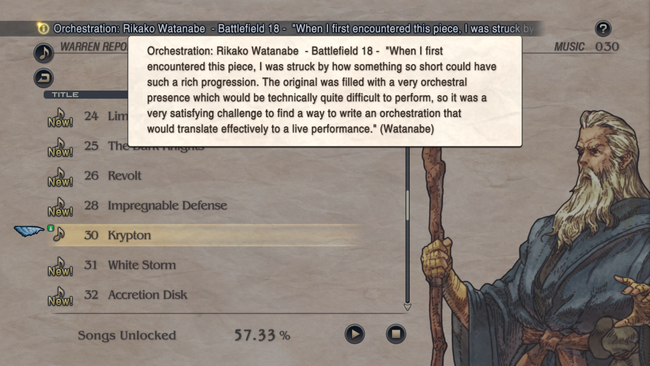
Tactics Ogre: Reborn is largely an excellent modern version of the classic strategy RPG. There are a myriad of improvements and enhancements to make it the most user-friendly version yet without compromising its difficulty. It is sometimes a delightfully brutal experience that pushed me to think carefully about my every move, though a lot of the gameplay alterations introduced in Tactics Ogre: Reborn didn’t jive with me for the most part. The primary suspects are the universally inflated stat values across the board and the new temporary stat increase cards among other nitpicks. Everything that I love about Tactics Ogre outside of its battle system remains intact with the branching narrative system, the ways you can recruit characters, and the overall presentation of one of the most interesting narratives in video game history.